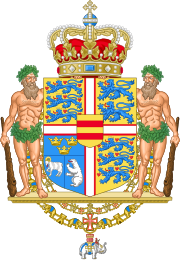April 1920 Danish Folketing election
| |||||||||||||||||||||||||||||||||||||||||||||||||||
All 140 seats in the Folketing 71 seats needed for a majority | |||||||||||||||||||||||||||||||||||||||||||||||||||
This lists parties that won seats. See the complete results below.
| |||||||||||||||||||||||||||||||||||||||||||||||||||
 |
|---|
Folketing elections were held in Denmark on 26 April 1920,[1] except in the Faroe Islands, where they were held on 20 May. The election campaign was the most aggressive and bitter in Denmark in the 20th century.[2] Voter turnout was 80.6% in Denmark proper and 58.8% in the Faroe Islands.[3]
Background
[edit]In what is referred to as Easter Crisis of 1920, on 29 March King Christian X dismissed the government,[4] the Cabinet of Zahle II consisting of members of the Danish Social Liberal Party, replacing it with a caretaker cabinet led by Otto Liebe on 30 March, as he was of the opinion that Central Schleswig should be returned to Denmark regardless of the outcome of the Schleswig Plebiscites. This led to massive protests and was referred to as a coup d'état by the Danish Social Liberal Party and the Social Democratic Party.[5] On 5 April 1920 a compromise was reached, the government was replaced with another caretaker cabinet headed by Michael Pedersen Friis and a new election was to be held as soon as possible.[6]
Electoral system
[edit]Prior to the elections, a new electoral law was enacted, with all seats now elected by party-list proportional representation in multi-member constituencies, with levelling seats used to make seat shares more proportional with national vote shares.[7] The districts elected between two and 15 members each.
Results
[edit] | |||||
|---|---|---|---|---|---|
| Party | Votes | % | Seats | +/– | |
| Denmark | |||||
| Venstre | 350,563 | 34.23 | 48 | +4 | |
| Social Democratic Party | 300,345 | 29.32 | 42 | +3 | |
| Conservative People's Party | 201,499 | 19.67 | 28 | +6 | |
| Danish Social Liberal Party | 122,160 | 11.93 | 17 | –15 | |
| Industry Party | 29,464 | 2.88 | 4 | +3 | |
| Centre | 9,056 | 0.88 | 0 | New | |
| Free Social Democrats | 7,260 | 0.71 | 0 | New | |
| Danish Left Socialist Party | 3,859 | 0.38 | 0 | 0 | |
| Total | 1,024,206 | 100.00 | 139 | 0 | |
| Valid votes | 1,024,206 | 99.70 | |||
| Invalid/blank votes | 3,082 | 0.30 | |||
| Total votes | 1,027,288 | 100.00 | |||
| Registered voters/turnout | 1,274,377 | 80.61 | |||
| Faroe Islands | |||||
| Union Party–Venstre | 3,117 | 64.48 | 1 | 0 | |
| Independents | 1,717 | 35.52 | 0 | – | |
| Total | 4,834 | 100.00 | 1 | 0 | |
| Valid votes | 4,834 | 99.71 | |||
| Invalid/blank votes | 14 | 0.29 | |||
| Total votes | 4,848 | 100.00 | |||
| Registered voters/turnout | 8,250 | 58.76 | |||
| Source: Nohlen & Stöver | |||||
References
[edit]- ^ Dieter Nohlen & Philip Stöver (2010) Elections in Europe: A data handbook, p524 ISBN 978-3-8329-5609-7
- ^ Wendt. "Rigsdagen 1915-40". Den Danske Rigsdag 1849-1949 bind II - Rigsdagens histore 1866-1949. p. 392.
- ^ Nohlen & Stöver, p. 537
- ^ Rosenkrantz, Palle (1934). Den danske regering og rigsdag 1903-1934 (in Danish). Copenhagen: Arthur Jensens Forlag. p. 46.
- ^ Rosenkrantz. Den danske regering og rigsdag 1903-1934. p. 47.
- ^ Wendt, Frantz W. (1951). "Rigsdagen 1915-40". In Fabricius, K.; Frisch, H.; Hjelholt, H.; Mackeprang, M.; Møller, A. (eds.). Den Danske Rigsdag 1849-1949 bind II - Rigsdagens histore 1866-1949 (in Danish). Copenhagen: J. H. Schultz Forlag. p. 388.
- ^ The Parliamentary Electoral System in Denmark Archived 2022-01-21 at the Wayback Machine Folketing

